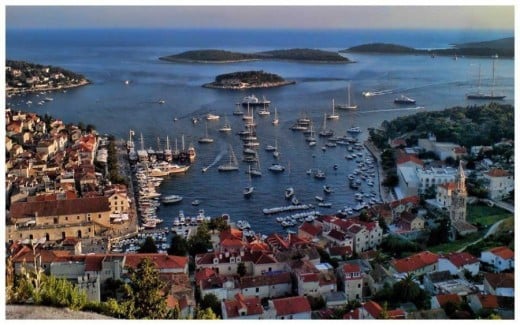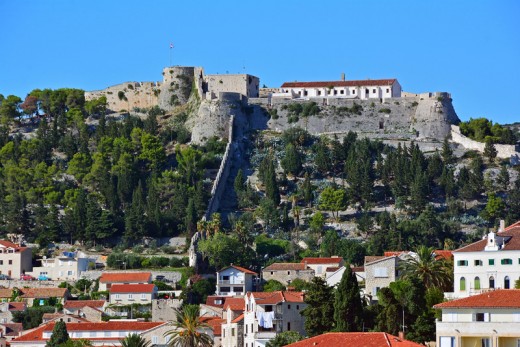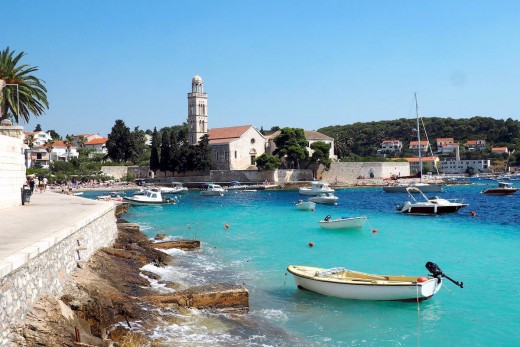Lavender Field Hvar Island Croatia
Hvar, the largest town on the island of the same name, is an appealing blend of Croatian charm and Venetian heritage. Motor yachts (often with celebrities aboard) and sailboats of all sizes are drawn to the “Lavender Island” by its near perfect climate and lively ambiance. Inviting beaches, secluded coves and a chilled glass of Bogdanusa, the island’s celebrated dry white wine, complete the picture.
The History of Hvar
Ample archaeological evidence indicates the island was first occupied by Neolithic tribes, who established trade routes with towns along the Eastern Mediterranean. At some point, whese earliest settlers moved on or died out, leaving the island to nature and the occasional visitor until Greeks from Paros arrived around 385BC, naming their initial settlement Pharos, Romans took over in 219BC, leaving behind a number of countryside villas and other structures. Slavic/Croatian tribes took over in the early Middle Ages, followed not long after by Venetians, who would introduce viticulture to the island, Venetian dominance lasted for several hundred years, until the ultimate disintegration of the Venetian empire in 1797.

Empires Ruling in Hvar
The Austro-Hungarian Empire ruled for most of the nineteenth century, followed by the Italians who occupied the island from 1918 to 1921, when Hvar and all of Croatia joined the Kingdom of Yugoslavia. Following World War II the Republic of Yugoslavia, under the dictatorship of Marshal Tito, would become part of the Communist Eastern Bloc. Various wars for independence (largely along ethnic lines) in the 1990s eventually led to the division of Yugoslavia into seven nations, including the present day Republic of Croatia.

Hvar Croatia Highlights
Here are Some Croatia Travel Information:
- The island eponymous town of Hvar each offer the visitor a number of pleasant distractions, made even more appealing by the renowned, seemingly endless pan of sunny days.
- The heart of Old Town is the 13th century St. Stephen’s Square or Trg Sveti Stjepan, around which one finds inviting cafes, shops and landmark Venetian St. Stephen’s Cathedral.
- Nearby, the multi-purpose Arsenal was used for food storage and as a repair station for Venetian ships; it also houses what is believed to be the oldest truly public theater in Europe, open to aristocrats and plebeians alike.
- Along the seafront, the Franciscan Monastery features an interesting small museum.
- Beyond the port, the towns of Stari Grad (literally Old Town) and Vrisnic are each worth a visit.
- More active pursuits include hiking or off road ATV jaunts through quaint hillside villages and forested back roads.
The Beautiful Place of Hvar Island Croatia
8 Other Famous Landmarks in Hvar
1. Hvar Fortress - Fortress perched high above Hvar town and been there for over centuries for the purpose of protecting Hvar.
2. Milna Island - Famous island located on the north west side of the Brac Island.
3. Harbour of Hvar - Most popular anchorage on the island. The harbour has fully equipped facilities which include moorings, electricity and water.
4. Mekicevica Beach - 5 star rating picturesque beach near Hvar.
5. Napoleon Fortress - French Fortress named after Emperor Napoleon. The Fortress was built just after the unsuccessful battle between French and Russia.
6. Hvar Public Theatre - Oldest public theatre in Hvar and first public theatre in Europe.
7. Benedictine Monastery - Monastery in Hvar that only follows the monastic living of St. Benedict.
8. Palmizana Botanical Garden - Paradise filled with exotic plants and wonderful landscape.

8 Things to Do in Hvar
Croatia Tourist Board
- Skydiving
- Boat Tours
- Bar, Club & Pub Tours
- Private Tours
- Water Sports
- Nature & Wildlife Tours
- Kayaking & Canoeing
- Wine Tours & Tastings
Other Must Visit Croatian Cities and Towns
- Game of Thrones Pride Dubrovnik Croatia
Nestled along the southernmost region of the Republic of Croatia lies one of the Mediterranean’s best kept destination secrets: Dubrovnik Called “the Pearl of the Adriatic,” by the poet Lord Byron, the city is rich in history and natural beauty. - Opatija Croatia Queen of Tourism
Pronounced o-pat-ee-ah, Opatija means abbey in Croatian. Deservedly hailed as “the Pearl of Croatia” as far back as the 1880s. Opatija first grew to prominence as the playground of Viennese aristocrats. - Split Croatia Second Largest City
Split is the largest and most important city of Croatia’s Split-Dalmatia County and the country’s second largest city. It is a Mediterranean city, situated on a small peninsula on the eastern shores of the Adriatic Sea. - Sibenik Oldest Croatian Town
Sibenik’s sheltered harbor at the confluence of the Krka River and the cerulean waters of the Adriatic fills with glossy yachts during the summer months, their owners drawn by its historic medieval Old Town.
© 2018 Travel Chef








